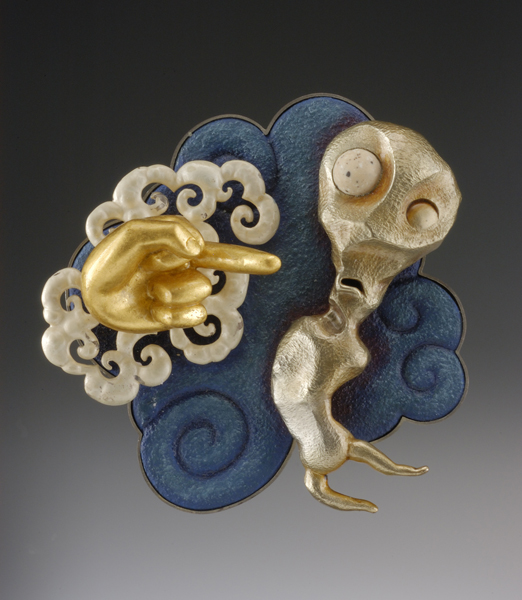
The numbers in the titles run quite high, into the hundreds and I find it hard to believe that there are literally hundreds of such carefully crafted objects in both series. I assume that Metcalf created many sketches of possible brooches and then made a few, the number in the title relating to the sequence of drawings, rather than actual objects. This would certainly make sense given Metcalf’s investment in the problematic of narrative art – the requirement to select a frozen moment pregnant with a sense of before and after.
All of the figures have plant heads, which are much larger than their bodies (so they are characteristic Metcalf figures) and their actions seem to be divided between tending the natural environment and playing music (with a couple of more inscrutable activities thrown into the mix). In terms of display, they are suspended upright on long gold-colored pins that attach to the brooch pin and then run into the plinth. This allows the figure to perform its activity and mimics the way you would encounter the brooch when worn, pinned on its backdrop of clothing.
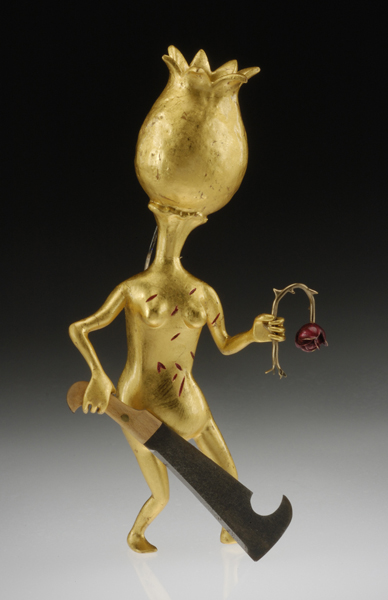
And most importantly, these figures, with their connection to the earth, in honest forms of labor, reveal Metcalf’s particular investment in a worldview that emerged in the 1960s, in which the values of care, of responsibility, of connection between people and the environment, of political action, are understood in a precise way. His jewelry has, for the past 30 years, been exploring the implications of this view of the world and the Wood Pins and Figure Pins are a single moment adding to Metcalf’s speculations about the human condition. As exhibition curator Signe Mayfield notes in the catalog, these brooches are related to Karl Blossfeldt’s book Art Forms in Nature (1928) in which microphotographs of plants reveal a fabulous world in close-up. ‘Metcalf mined Blossfeldt’s images of leaves, fern heads, and seed pods for their iconic qualities and transformed them into heads for his carved, sometimes pot-bellied, figures,’ writes Mayfield. ‘No longer big-headed protagonists, these strangely credible, surreal hybrids offer up responsible actions in the collision of culture with nature by actively fixing things, protecting a seed, gardening, or providing sustenance.’
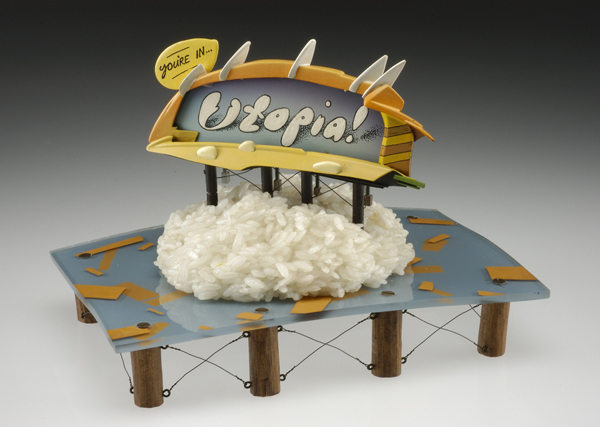
So if the Wood Pins and Figure Pins sit awkwardly according to the framework I carry as a default position because of my background, do they succeed according to another set of terms? I believe they do. They are skillful, inventive, absorbing of your attention and they reward study, establish interesting relations with the viewer. They take the narrative tradition of jewelry in an interesting new direction. They are wearable. As far as I can see, they satisfy all the demands required of contemporary jewelry: conceptual, historically literate, sophisticated in their potential to intervene in the communicative square of maker-wearer-viewer-object. And finally they are excellent within the terms of Metcalf’s own production – an expression of the 1960s idealism and humanism and belief in craft as a transformative activity that animates his work.
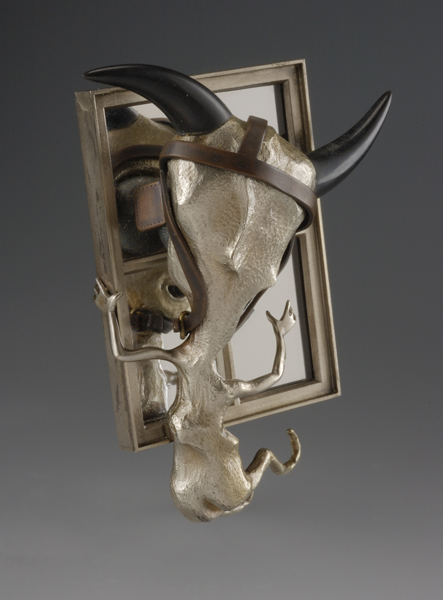
I was a little disappointed with the introductory wall text, which is mostly taken up with a catalog of Metcalf’s achievements as a writer/jeweler. Given that the exhibition has such a strong, intentional point to make in relation to Metcalf’s work – and one that some viewers might find contestable – it would have been useful to see this addressed more directly. But this text does raise the important question of whether Metcalf’s work is jewelry or sculpture. As Mayfield writes, ‘Whether Metcalf’s work is at rest as compelling sculptural form, or worn out in the world as jewelry to the surprise of an unsuspecting public, it is certain to provoke thought and meaningful conversation.’

The exhibition features peephole cases, through which you look at the work. The intention seems to have been to force the viewer into a particular scale relationship with the objects, so that the sense of smallness would be overcome. While they do this, looming large when you look through the peephole, they are also hard to see (meaning many viewers won’t bother) and I wonder if the peephole doesn’t introduce a whole range of other meanings (such as voyeurism) that aren’t so useful. Is it intentional that we see Second Theology Lesson (1998) in which God’s hand instructs/strikes a hapless human figure, from what can only be described as the eye of God perspective? In other cases the relationship is quite nicely handled. A series of Figure Pins from 1996 and 1997 all have damaged or deformed body parts, meaning that the peephole cases actually work quite well in implying a sense of choice, of forbidden or off-limits viewing.
As you move about this exhibition you start to develop a good sense of the range of Metcalf’s jewelry and its various concerns. Take, for example, the Design Lesson brooches, about modernism and the various dogmas of art that Metcalf has tried to address and overcome in his work. The curatorial strategy works strongly here, kicking into gear to pull together a cluster of nine brooches that together make clear Metcalf’s anti-modernist statement, neatly installed into a vertical case that sits at the intersection of two walls. Two Views (1996) and the Sentry Box brooches (1990) in this context talk about paradigms and gatekeepers, while in between them the various Design Lesson brooches and Pomo Party Hat (for Philip Johnson) (1990) stage Metcalf’s resistance to modernism. It’s nicely done, never too heavy handed but always to the point.

This is really how the show is organized, groups of work displayed together to explore themes that are important within Metcalf’s jewelry. Sometimes these present series or bodies of work by the jeweler, such as a group of brooches about love from 1999, but other times brooches from different periods will be pulled together to represent a theme. These include topics such as the possibility and probability of hope, acts of service for self and other (including the redemptive possibilities of craft) sustenance and sharing. You can begin to see that Metcalf’s work is essentially stubbornly unfashionable and why it might be seen as sentimental – he cares, he believes, he hopes and he makes jewelry about it.
I’m not sure how convinced I am by the more diorama-style works, such as Advent of the Damaged Angel (1997) or Life Among the Mummies (1997). When the architecture becomes a stage, rather than part of the jewelry (where the game is to make something small yet monumental) it runs the risk of becoming dinky, cute, overly sentimental and ultimately lazy. And it also runs the risk, in this context, of being unfavorably compared to the scaled-down train model that Metcalf built for Marklin HO trains, also in the show, which is a detailed model railway, a scene of a village near Munich in the middle of winter. The stages have nothing on this quite astounding model train, as they are neither jewelry nor model and therefore they miss out on what makes Metcalf’s jewelry and his miniature railway wonderful objects.
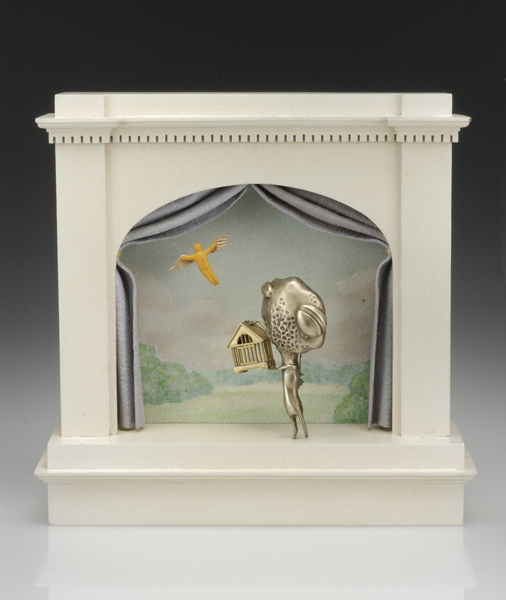
The model/jewelry which is most successful, in my opinion, are the objects from the 1970s: A Light Lost at Sea (1977), Vessel with a Cargo of Light (1980), You’re in Utopia (1978), Pewter Peanut with Box (1973), and Worms from Mars Invade an Authentic New England Village (1971). All of these do something essential with their object-ness, their model-ness. That they are tableau, toys, small models, is somehow essential. It makes them zing and amplifies their message. (The plastic perfection of You’re in Utopia at model scale because utopia cannot hope to exist any larger; the Pewter Peanut with Box mocking art world, craft and toy collector pretensions while also delighting in the possibilities of whimsical obsession; and the parodic joy of crazy combinations in Worms from Mars . . . , the sheer wonder that such an object can exist, the possibility that some kid might actually own and play with it and how that would short-circuit the industrial-military complex and the imperial narratives of America.)
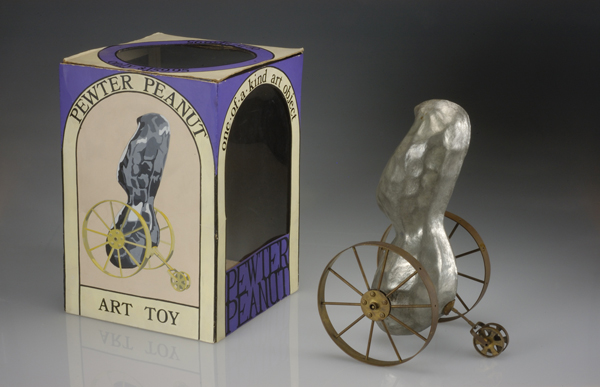
Still, by the end of this exhibition I found myself convinced and involved, which is surely the best indication that The Miniature Worlds of Bruce Metcalf is successful. There’s a lovely pace here, both complicated and straightforward, where the fullness and richness of Metcalf’s jewelry is allowed to happen without any great work of education going on. The show, in other words, seems to share the qualities of Metcalf’s jewelry: an act of kindness and faith that, if you want to take the time to look, is easy to connect with.
After seeing Metcalf’s show, you know the world is still a terrible place, but you see the beauty of futile resistance, the majesty of the small gesture, the elegance of acting in the face of the knowledge that you will almost certainly fail. And you see that this – which is also a metaphor for the work of the jeweler, who takes the same risks, hopes in the same way, with every piece of jewelry – is really success.





